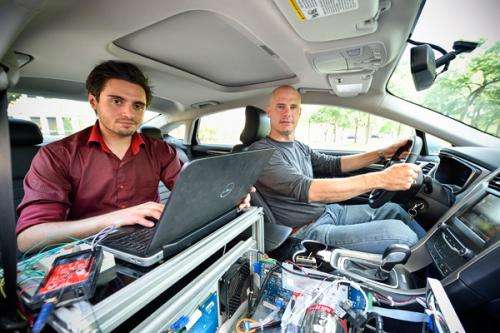Portable nanospectrometer for detecting dangerous compounds

Guido Verbeck, UNT associate professor of chemistry and biochemistry, patented an algorithm that works with a high-tech tool to detect the location of chemical streams. Now, he's using it in technology that can detect not only chemicals, but biological threats. His newest device, a mobile nano spectrometer, can be used in a moving vehicle to investigate attempts at creating biological warfare, examine environmental concerns, find clandestine laboratory locations, protect military bases and determine the toxicity of HAZMAT spills.
"This device can target aromatic compounds such as biofuels, chemicals used in oil and gas procurement, drugs and even determine disease states," Verbeck says. "This is the first technology of its kind that can detect both chemical and biological threats at the same time."
Verbeck's latest version of the detection tool "breathes" the air through a sensor to detect dangerous compounds and can fractionate a plasma source to determine if biological weapons are present. He is testing the technology at a missile base to fine tune it for detection of everything from anthrax and ricin to deadly viruses that could decimate populations.
"We wanted to develop an instrument with a higher throughput," he says. "This version allows for rapid response ― three second detection of chemicals and biological agents. It's also made for ease of use. You don't have to be a scientist to operate it."
Verbeck's goal is to create a software for the system that prevents the need for viewing data and, instead, provides up front information that can be processed in real time. He's currently working with Thermo Fisher Scientific, a world leader in biotechnology product development that has provided a $2 million grant, to get this patent ― and two others ― executed.
"I currently hold 12 patents for modified mass spectrometers and my nanomanipulator," Verbeck says. "My goal is to have 50 percent of them active. At this time, three are. When Thermo Fisher puts these three into action, I will have met that goal."
Verbeck says he understands the potential for civil liberty concerns with this type of technology and is working closely with Kimi King, a UNT political science professor and civil rights expert, to pursue grants from the National Institute of Justice.
"I'm being proactive. I want to make sure this technology is developed in the best legal way possible," Verbeck says.
Verbeck has already received his first royalty check of $10,000 for his chemical detection algorithm patent.
"This is only the first check," Michael Rondelli, associate vice president for innovation and commercialization in the Office of Research and Innovation, says. "We expect a lot more as this exciting new technology gets to marketplace."
Verbeck says a strong partnership with the university's technology transfer team, which is led by Rondelli, was a major factor in the commercial success.
"As researchers, we can keep doing our work without losing any stride thanks to UNT's tech transfer office," Verbeck says. "Product output needs to continue to be a focus at UNT so our ideas can translate from the laboratory to the real world. We're still building up that profile."
Provided by University of North Texas



















